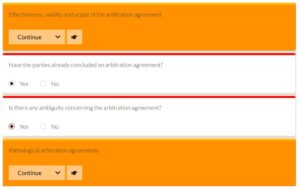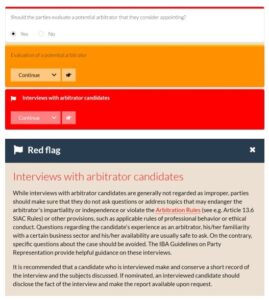In June 2020, the Swiss Arbitration Association (ASA) launched its much-awaited Arbitration Toolbox, an online and interactive tool that guides a user through the various stages of an arbitration. Initially the brainchild of former ASA President, Elliott Geisinger, the Toolbox was brought to fruition under the presidency of the current ASA President Felix Dasser. The project was chaired by Elliott Geisinger, Gabrielle Nater-Bass and Andrea Meier, with an editorial team comprising of Stefanie Pfisterer, Dilber Devitre and Antonio Ardielli.
This post introduces the Arbitration Toolbox, its purpose, functionality and potential to assist arbitration practitioners, scholars and enthusiasts with their work.
The overarching goal of the Toolbox is to make arbitration proceedings more efficient, by showing that the proceedings can – and should – be tailored to the circumstances of a given case and the needs of the users (being first and foremost those of the parties). The purpose of the Toolbox is to highlight the different approaches to conducting an arbitration, thereby decrying the popular belief that “one size fits all”. The Toolbox emphasizes the flexibility of arbitral proceedings and provides guidance on which approach is advisable in a given situation. The Toolbox aims to provide practical and useful information to users on the various aspects of the arbitral process.
The Toolbox is designed as an electronic platform that guides a user through the various stages of an arbitration procedure. It is not intended to be an online and academic encyclopaedia, but rather, its focus is practical. The Toolbox is organised into sub-sections that follow the general steps involved in an arbitration. Users can dive into the Toolbox at any sub-section, thus making it easier for them to find the information they are looking for.
The Toolbox is organized according to the following steps in an arbitration, all of which contain various sub-sections:

Once in a given sub-section, users can navigate their way through a series of questionnaires and decision trees to find the specific information they are looking for.
Below is an example of a questionnaire in the section on “Commencement” of an arbitration:

The Toolbox also includes various practical tools such as checklists and examples of procedural orders and submissions that the users can download.

Likewise, “red flags” incorporated into the various sections of the Toolbox warn users about controversial and tricky issues to which special attention must be given. For example, users get alerted to the advantages and perils of arbitrator interviews as the image below illustrates.

Although developed under the aegis of ASA, the Swiss Association of Arbitration, the Toolbox is entirely independent of the applicable lex arbitri or the institutional rules and can thus be used by anybody, anywhere, for any arbitration, institutional or ad hoc, irrespective of the seat. Due to this and given its complementarity with the UNCITRAL Notes on Organizing Arbitral Proceedings, which also aim to make arbitration proceedings more efficient, ASA has collaborated with UNCITRAL on the Toolbox project. The Toolbox now features on the UNCITRAL website as an additional resource to the UNCITRAL Notes on Organizing Arbitral Proceedings.
The Toolbox is specifically designed for users of all levels of experience. Because the Toolbox is based on questionnaires, experienced practitioners may find it useful to question whether the “standard way of doing it” makes sense in a given case or whether there is a more appropriate and efficient way of handling a given arbitration. On the other hand, several features of the Toolbox such as the pop-up definitions and the explanation boxes are aimed at and will be of service to the less initiated practitioner. The Toolbox is also a useful educational tool and can be used by students interested in learning the practical aspects of international arbitration. The Toolbox is available free of charge on the Internet and can be accessed here.
The current version rolled out by ASA is the first version of the Toolbox. However, the Toolbox will be updated at regular intervals in order to keep it up to date with the latest developments in international arbitration. Future versions may be expanded to cover investment arbitration and include further practical and useful tools. Any feedback on the Toolbox from KAB readers would be welcome!
ASA’s president, Felix Dasser, commends the Toolbox: “This is not another guideline. ASA is not trying to tell the world how it should arbitrate. We do not pretend to be smart enough for that. ASA is simply providing all of you with a tool to make best use of your skills under your specific circumstances.”
________________________
To make sure you do not miss out on regular updates from the Kluwer Arbitration Blog, please subscribe here. To submit a proposal for a blog post, please consult our Editorial Guidelines.


